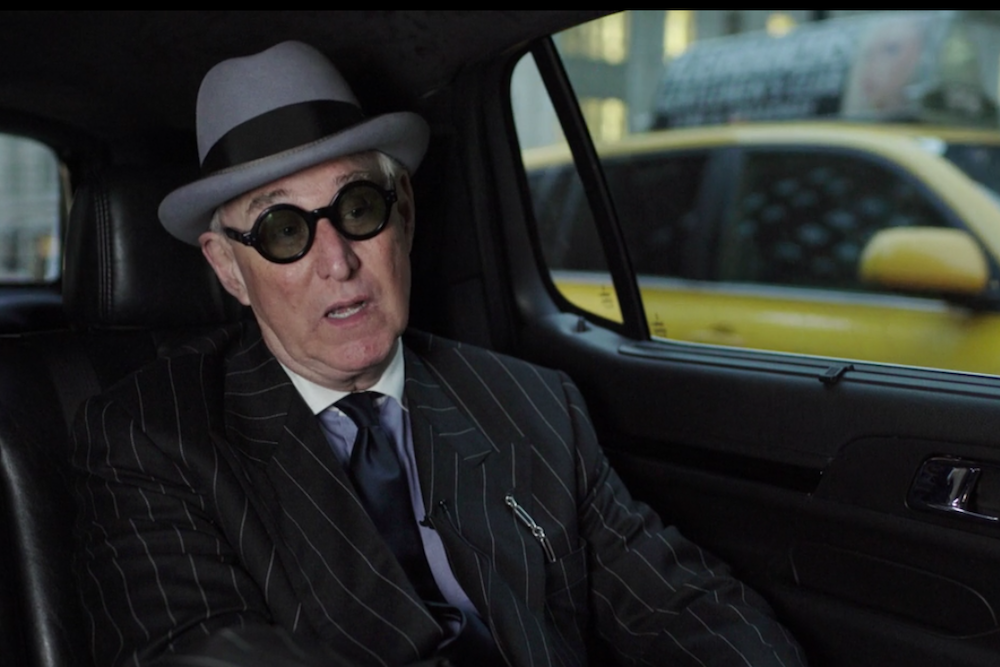Near the end of the new Netflix original documentary Get Me Roger Stone, a filmmaker asks the titular right-wing political operative and self-described “agent provocateur” what he would say to members of the audience who would come away hating him when the film’s credits rolled. “I revel in your hatred,” Stone answers quickly, dressed like a cross between Boris Badenov and Danny Devito’s Penguin in the back of a limousine. “Because if I weren’t effective, you wouldn’t hate me.”
The scene is as good an encapsulation as any of Stone’s haughty and theatrical personal brand, and it neatly summarizes the chief issue journalists and documentarians face when attempting to cover his exploits with a critical eye. Stone’s career in national politics began with the committee for the reelection of President Richard Nixon in 1972, where his most lasting achievement was a fake donation made in the name of the Young Socialists Alliance, with hopes of sullying the reputation of one of Nixon’s competitors. More recently, Stone was a campaign advisor and all-around confidant to Donald Trump during the 2016 election. After several decades filled with attack ads, covert maneuverings, and disinformation campaigns, he is known as Washington’s consummate “dirty trickster.” Stone actively cultivates that reputation, because he sees it as a reflection of his power and influence–which isn’t to say that it’s untrue. How do you make a film that shows him as the cynical manipulator he is without burnishing the myth, giving him exactly what he wants?
The question animates much of Get Me Roger Stone, which presents its subject as a key figure of the last half-century of political history–“the sinister Forrest Gump of American politics,” as the New Yorker writer Jeffrey Toobin memorably terms him in an interview for the film. Toobin doesn’t mean that Stone is stupid, but that he has a propensity for showing up at pivotal moments. After Watergate derailed his hero’s presidency, Stone cofounded the National Conservative Political Action Committee, a group that pioneered the use of campaign finance law loopholes to flood candidates with cash, precipitating the way elections are bought and sold today. In the early 1980s, as a partner in the firm Black, Manafort, and Stone, he became one of the first Washington power brokers to move directly from working on campaigns into the lobbying industry, selling influence and access to the politicians he’d just helped elect. The practice was frowned upon as an ethical breach at the time, but is now common. (Lee Atwater, subject of a 2008 documentary that feels like a close antecedent for Get Me Roger Stone, was also a partner in the firm.)
Get Me Roger Stone makes its most compelling argument through this retelling of its subject’s early career: that Stone, through his willingness to flout previously accepted norms of how campaigns were conducted, in the service of his own personal enrichment, helped to create Washington’s “swamp” of corruption that Trump has promised to drain. The two men have been friends for decades, and Stone has been urging Trump to run for president since the ‘80s. As Jane Mayer, another New Yorker writer, puts it in the film: “Roger is the ultimate insider, which makes him incredibly good at seeing how to package someone he could sell as an outsider.”
Stone revels in the camera’s attention, even as he seems to know how the documentary might turn out. (Multiple times, he half-jokingly warns friends and associates that the filmmakers are “liberals” and “pinkos,” and thus not to be trusted.) He’s seen in a parade of absurd dandyish outfits: a three-piece suit in beige, overcoat with huge mobster lapels draped on his shoulders like a supervillain’s cape; a cream jacket with an overflowing pocket square that looks like it’s trying to escape the forced captivity it’s enduring next to his pecs. Directors Morgan Pehme, Dylan Bank, and Daniel DiMauro deftly walk the line between documenting Stone’s showboat impulses and indulging them. At one point, he describes his role in the Florida recount that led to George W. Bush’s election as president in 2000, claiming to have orchestrated the so-called “Brooks Brothers riot” of protesters who were opposed to the recount. Then, Tucker Carlson, another interviewee, laughs and says that Stone’s role that day was tangential at best. Stone’s actual efforts to elect Bush–a stalking horse scheme involving Pat Buchanan, the Reform Party, and a head-fake presidential candidacy from Donald Trump–were far more elaborate, and sinister.
According to several interviewees, Stone’s turn from mainstream GOP party politics toward his current role as a friend to fringe candidates like Trump and frequent conspiracy theory-spouting guest on Alex Jones’s InfoWars may have begun with a sex scandal. When Stone was an advisor on Bob Dole’s 1996 presidential campaign, the National Enquirer alleged that he’d placed several ads in swingers publications seeking people to have sex with him and his wife. Ironically, Stone initially tried to claim that he’d been the victim of a dirty trick, before eventually acknowledging that the ads were real. At one point in Get Me Roger Stone, a Stone protege muses that without the swinger scandal, “we might have had a president Al Gore.” Considering Stone’s efforts on behalf of Trump, it follows from that observation that we might also have had a president Hillary Clinton. When Stone praises Trump in the film for “kicking the political establishment in the balls,” it’s easy to imagine his bile stems in part from his own banishment from that establishment in the ‘90s.
If you can get over the fact that Stone himself probably sees it as a testament to his legacy, Get Me Roger Stone is a revelatory film, though it devotes surprisingly little time its subject’s personal ideology. He briefly mentions a political awakening upon reading Barry Goldwater’s era-defining 1960 book The Conscience of a Conservative, and discusses his libertarian beliefs about pot legalization and gay marriage. But for the most part, you’re left to believe that like Trump, Stone is motivated to go to work each day not by a desire to bring about some political ideal, but by the thought of his own success and the attention he believes will follow.
Get Me Roger Stone reaches its climax on November 8, with an increasingly frantic montage of crying Clinton supporters and harried cable news anchors announcing the surprising election returns in states like Wisconsin and Michigan. When Trump is announced as the victor, Stone and Jones are shown giving a champagne toast on the InfoWars set, where they’d hosted their own election-night broadcast. The camera lingers on Stone’s face in the moments after that brief celebration, and he doesn’t smile or chat with his co-host, but stares blankly ahead. More than anything, he looks lonely.





